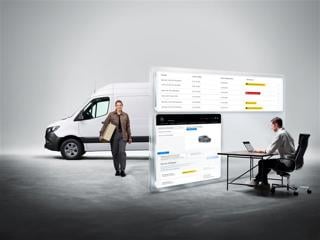Like so many parts of the automotive industry, the tyre sector is undergoing enormous and rapid changes.
From new technologies to an ever-increasing number of different tyre sizes, as well as cost challenges and a sharper focus on sustainability, these changes will impact on the operation of a fleet.
“Tyres have never gone through as many changes as they are going through at the moment,” says David Legg, director of tyres for i247 Group.
“I’ve worked in the sector for 35 years and the current pace of innovation is unlike anything I’ve ever seen.”
This is because a number of factors have come together to radically change the tyre landscape – not least electric vehicles and the focus on sustainability.
“As cars and vans have advanced, the R&D that manufacturers have had to put in to keep up with the changes in vehicles has been huge,” he adds.
“It’s the same with trucks. Truck tyres have seen a huge advance in technology; where manufacturers used to bring a pattern out every couple of years, new tyres are coming out at apace.
“This is because the manufacturers are trying to find solutions to many problems.”
Legg says to help organisations better understand the issues, i247 has produced a white paper entitled The Evolving Tyre Landscape – What Fleets Need to Know, which can be downloaded by clicking here.
This feature looks at some of the main issues highlighted in the report.
Proactive approach to tyre management is key
The ever-greater number of EVs and trend for large rim sizes mean there is no longer a small subset of common tyre sizes, with many modern vehicles needing unique tyre sizes and types.
Dedicated EV tyres, for example, are constructed to cope with the additional strain caused by the significant weight of the vehicle’s battery, while it is crucial they also have low rolling resistance for quiet running and optimised range.
But as EVs account for a fraction of the overall demand and the tyres are less sought-after, there is little requirement for fast-fits to hold stock of them.
The general view is there will be a lag until EV tyre changes are a dominant part of day-to-day fast-fit business.
“The fast-fits are trying their best but they are no different from someone like Tesco in that if something sits on the shelf then it has to come off on a regular basis to pay for itself,” says Legg.
“Fast-fits have to keep a stock level of tyres for the retail market which is their bread and butter, and it is part of the market which is becoming bigger.
“Some people still drive straight to a fast-fit when they need new tyres because they think they there are massive warehouses behind each of them, and what they need will be in stock, but it’s not like that.”
For the driver, this could mean a wasted trip and having to make a repeat visit to the tyre fitter.
Legg advises company vehicle drivers to always book ahead to ensure the right tyres are there when needed.
He says EV drivers should be told when they take delivery of their vehicle that replacement tyres may take longer to be in stock than traditionally expected, which makes regular tyre checks to detect any issues important.
“It’s a simple message from delivery which can keep that driver proactive and ensure they check their tyres more often,” he adds.
Smart use of data can control costs
The tyre industry is facing a number of cost challenges. There have been significant price rises in raw materials, including carbon black, while the ongoing Ukraine conflict has increased energy and oil costs essential to manufacturing.
The cost of logistics has also risen due to higher container freight rates and fuel prices, and there has been an upward pressure on wages due to challenges in attracting and retaining skilled tyre fitters.
Additionally, increased demand for larger and more expensive tyres, driven by the popularity of SUVs and electric vehicles, puts pressure on fleet budgets.
However, fleets can mitigate the increased costs by astute analysis of data, says Legg.
“Procurement would have probably procured a tyre deal based on a unit price, not on the data from the vehicle,” he adds.
“But we did a case study recently with a courier company, which are probably the worst burners of tyres you can get particularly if it’s last-mile delivery; there is a lot of damage.
“We had four years of data on this fleet, which has 5,000 vehicles, so we were able to look at what came off, what went on etc.
“We looked at three premium tyre brands and over the life of the five-year contract, the difference in spend between them was just under a million pounds.
“Basically, the most expensive tyre unit turned out to be the cheapest in the long run, because it sustained less damage which meant that fewer were fitted.
“This result will probably be different for another fleet with different use cases, different vehicles or different tyre sizes; the cheapest tyre overall could well work out to come from a different manufacturer.”
Legg says this type of analysis may not work as well for smaller fleets. “But if you’re a big fleet with a lot of identical vehicles, you should be able to use your own data to tell you what’s best for your fleet,” he adds.
Sustainability
Fleets and private buyers should be aware their choice of tyre brand will have a huge impact on both the wear rate and toxic content of the tyre and the variations are significant, says the white paper.
Germany’s ADAC, Europe’s largest motoring association, carried out a comprehensive tyre particulate study in 2022.
It assessed the environmental impact of tyre abrasion on almost 100 tyres across 15 manufacturers.
Clearly there is also a balance to strike between low abrasion and maintaining safety, so ADAC also tested the safety of environmentally friendly tyres and concluded that: “Only two manufacturers currently achieve a particularly good balance between safety and the environment; Michelin and Goodyear.”
Businesses looking to decrease their tyre pollution impact could take the following actions:
- Procure tyres with a low level of wear. This not only drives cost efficiencies, but also protects the environment.
- Encourage drivers to check tyre pressures regularly. Under-inflation can increase wear as much as over inflation.
- Educate drivers to maintain an even driving style to ensure low fuel consumption and reduce tyre wear.
- Raise awareness of the impact of tyre pollution and how driving style can reduce environmental impact.
New tyre technologies
Electric cars and the move towards autonomous vehicles are accelerating tyre innovation with a focus on sustainability and maintenance-free tyres, says the report.
Tyre manufacturers are exploring alternative materials, while airless or non-pneumatic tyres are also being developed which offer reduced maintenance and environmental impact.
“We are also seeing innovations such as intelligent tyres which provide real-time connected tyre data,” says Legg.
These use small sensors and the data produced includes traction, tread wear, temperature and load. A more connected, data driven approach will allow for more proactive provision of in-life fleet maintenance.
Other innovations include airless tyres, with a number of manufacturers having started production of them.
Airless tyres are designed specifically so that they do not need air pressure in the same way as a conventional tyre.
Instead, they have a special structure made up of spokes which maintain tyre shape and a special footprint to ensure surface contact.
The tyres are maintenance free, apart from an occasional re-tread, bringing both business and environmental benefits.
“The airless tyre will hopefully support the van industry massively,” says Legg. “I don’ t see it being on everyday cars, but definitely the van fleet.”






















Login to comment
Comments
No comments have been made yet.